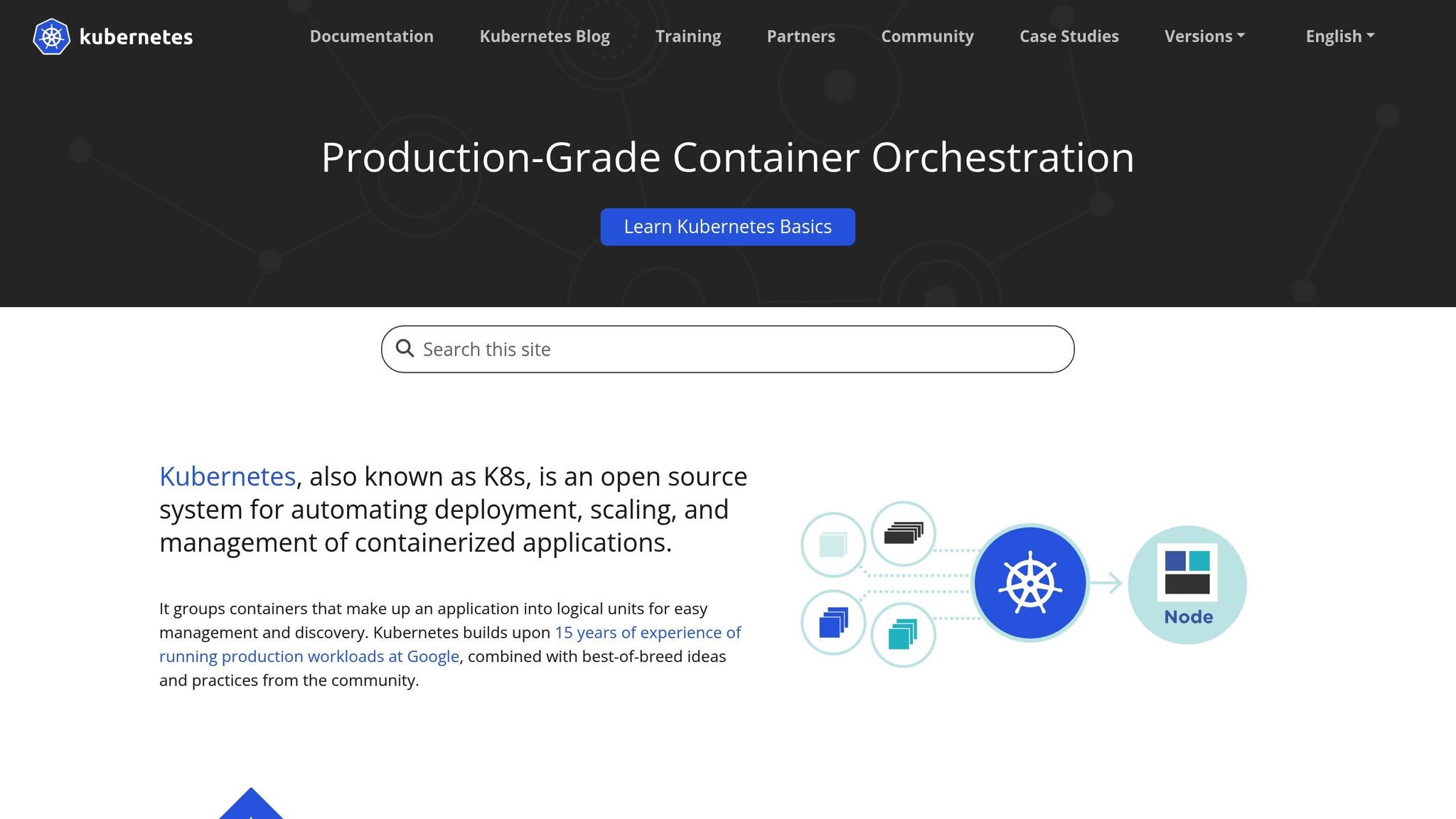Kubernetes can help small and medium businesses (SMEs) save money, scale operations, and improve system reliability. SMEs often face challenges like limited budgets and small teams. Kubernetes addresses these by automating resource management, reducing IT costs, and ensuring smooth performance even during growth.
Key Benefits of Kubernetes for SMEs:

- Cost Savings: Cut IT costs by up to 40% through automation and efficient resource use.
- Scalability: Handle fluctuating workloads with tools like autoscaling.
- Portability: Run apps across multiple clouds, avoiding vendor lock-in.
- Reliability: Features like self-healing and failover keep systems stable.
Common Use Cases:
- Faster Software Development: Automate deployments and speed up prototyping.
- Multi-Cloud Management: Balance workloads across different cloud providers.
- Enhanced Security: Protect data with built-in security features like network policies and audit logging.
For SMEs just starting with Kubernetes, assess your IT needs, choose a platform (e.g., DigitalOcean or Azure), and train your team. Kubernetes offers a clear path to cutting costs, improving efficiency, and enabling growth.
Main Advantages of Kubernetes for SMEs
Cutting IT Costs
Kubernetes helps small and medium enterprises (SMEs) save money by automating resource management, which reduces unnecessary expenses. In fact, SMEs can lower their operational costs by as much as 40% through efficient resource allocation and consulting services. Here’s how Kubernetes achieves these savings:
| Area of Savings | Benefit |
|---|---|
| Resource Optimization | Automatically scales resources to avoid waste during low-demand periods |
| Labor Reduction | Automation reduces the need for manual monitoring and deployment |
| Infrastructure Efficiency | Prevents overprovisioning by setting resource limits |
| Operational Streamlining | Self-healing features minimize downtime and reduce associated costs |
In addition to saving money, Kubernetes is designed to grow with your business, ensuring that resources are allocated efficiently as demand increases.
Scaling with Business Growth
Kubernetes stands out for its ability to handle fluctuating workloads, thanks to its advanced autoscaling features. It offers three main tools for scaling:
- Horizontal Pod Autoscaler (HPA): Adjusts the number of pod replicas based on current demand.
- Vertical Pod Autoscaler (VPA): Dynamically allocates CPU and memory to meet workload requirements.
- Cluster Autoscaler: Adjusts the number of nodes in the cluster depending on overall resource needs.
These capabilities don’t just handle growth; they also improve efficiency. Automated scaling can cut deployment times by 50% and increase uptime by 35%. This means SMEs can scale their operations without needing to hire additional IT staff.
"With autoscaling, you can automatically update your workloads in one way or another. This allows your cluster to react to changes in resource demand more elastically and efficiently." - Kubernetes Documentation
While scaling ensures growth, maintaining a stable system is equally important.
Ensuring System Stability
Kubernetes doesn’t just scale efficiently - it also keeps systems running smoothly. Built on over 15 years of Google’s experience managing production workloads, the platform incorporates industry best practices. Features like automated health checks, rolling updates, and continuous monitoring ensure that systems remain stable.
To maintain this stability, SMEs should focus on:
- Setting up robust monitoring tools
- Configuring resource limits for all components
- Implementing health checks for pods and other system elements
Kubernetes automatically removes unhealthy pods and replaces them with functioning ones, reducing the need for manual intervention. This reliability allows SMEs to spend less time worrying about infrastructure and more time focusing on growing their business.
Common Uses of Kubernetes in SMEs
Speeding Up Software Development
Kubernetes simplifies and accelerates software development by automating deployments and enabling faster prototyping. For instance, Bose Corporation successfully manages over 30,000 non-production and 1,250+ production deployments every year using Kubernetes.
"We needed to provide a mechanism for developers to rapidly prototype and deploy services all the way to production pretty fast." – Josh West, Lead Cloud Engineer at Bose
To make development processes smoother, consider these key practices:
| Development Practice | Business Impact |
|---|---|
| GitOps Integration | Ensures consistent and trackable configuration management |
| Automated Deployments | Minimizes manual errors and speeds up deployment cycles |
| Service Decoupling | Allows independent scaling and updates for services |
| CI/CD Pipeline Integration | Simplifies testing and deployment workflows |
In addition to speeding up development, Kubernetes provides flexibility for strategic deployments.
Running Apps Across Multiple Clouds
Kubernetes is particularly effective for multi-cloud deployments, where it manages load balancing, traffic routing, and resource allocation across various cloud providers and even on-premise servers.
For seamless multi-cloud management, you can adopt these strategies:
- Use consistent deployment practices across all environments.
- Leverage Infrastructure as Code (IaC) to maintain uniform configurations.
- Set up centralized monitoring to oversee all cloud environments.
- Standardize security protocols across platforms for unified protection.
Beyond development and deployment, Kubernetes also strengthens business operations with its built-in security capabilities.
Protecting Business Data and Operations
With cyberattacks growing by 168% year-over-year, safeguarding business data is more critical than ever for SMEs. Kubernetes offers strong security measures to protect both data and operations.
| Security Feature | Protection Provided |
|---|---|
| Network Policies | Regulates pod-to-pod communication for better control |
| Pod Security Standards | Enforces compliance with security requirements |
| API Server Security | Manages authentication and access permissions |
| Audit Logging | Keeps a detailed record of cluster activities |
| Automated Monitoring | Detects and mitigates potential threats |
"Enabling immutability, creating backups with unique code paths, protecting backups for maximum effectiveness, and enabling seamless restores are part of a robust ransomware data protection strategy." – Anthony Spiteri, Senior Global Technologist at Veeam Software
"The inherent portability and immutability of containers make it easier to replicate a complete application stack consistently at multiple locations." – Tony Iams, Gartner analyst
Getting Started with Kubernetes
Checking Your IT Requirements
Before diving into Kubernetes, it's essential to assess your current IT setup. This includes evaluating your infrastructure, team expertise, security protocols, and budget. Many organizations face challenges like limited cloud-native knowledge and resource constraints, so starting with a clear understanding of your needs is crucial.
| Assessment Area | Key Considerations |
|---|---|
| Infrastructure | Current computing resources, network capacity, and storage requirements |
| Team Skills | Proficiency in Linux administration and experience with containerization |
| Security Needs | Compliance requirements and data protection standards |
| Budget | Costs for infrastructure, training, and ongoing maintenance |
If your team is new to containerization, it's wise to begin with the basics before tackling Kubernetes. Establish a solid foundation in security practices and operational readiness that align with your organization's goals. Once you've completed this evaluation, the next step is selecting a Kubernetes platform that fits your requirements.
Selecting a Kubernetes Platform
With 96% of organizations either using or exploring Kubernetes, choosing the right platform is a key decision. For small and medium-sized enterprises (SMEs), cloud providers offering straightforward and budget-friendly solutions are often the best choice. Here's a quick comparison of some popular options:
| Provider | Best For | Key Advantages |
|---|---|---|
| Digital Ocean | Small teams | Easy-to-use interface and simple setup |
| Linode | Startups | Quick cluster deployment and competitive pricing |
| Azure Kubernetes Service | Microsoft-based teams | Comprehensive dashboard and integrated tools |
Starting with a pilot project can help you test the waters and evaluate a platform's suitability. For instance, The New York Times successfully migrated to Kubernetes, slashing deployment times from hours to minutes while achieving better scalability.
"If you are a small startup without a lot of infrastructure experience, I do not recommend AWS, Azure, or GCloud. Their user experience is terrible enough to be a deterrent."
- Elliot Graebert, Director of Engineering at Skydio
Training Your IT Team
A well-trained team is vital for a smooth Kubernetes adoption. Develop a training program that balances theoretical knowledge with hands-on practice. Here's a three-step approach to get started:
- Foundation Building: Begin with introductory courses and practical labs to establish a strong understanding of Kubernetes concepts.
- Practical Experience: Use real-world scenarios to apply theoretical knowledge, focusing on deployment and troubleshooting skills.
- Security Training: Emphasize key areas such as:
- Best practices for container security
- Setting up network policies and access controls
- Meeting compliance standards
- Threat detection and response strategies
"Now that products have become more stable, the technology is ready to enter the mid-market."
- Murli Thirumale, VP and GM of Pure's Cloud-Native business unit
To ensure ongoing success, consider creating a Kubernetes Center of Excellence. This initiative can help centralize expertise, promote best practices, and support continuous learning across your organization.
sbb-itb-bec6a7e
The Multi-Cloud Expedition Episode 7: Simplified Kubernetes Management
Conclusion: The Impact of Kubernetes on SMEs
Kubernetes is reshaping IT strategies for small and medium enterprises (SMEs), offering a powerful solution for modernizing infrastructure. With the market expected to hit $9.7 billion by 2031, growing at an impressive 23.4% annual rate, Kubernetes has become a cornerstone for businesses aiming to stay competitive.
The cost benefits are hard to ignore. Many SMEs report IT cost reductions of up to 81%, with infrastructure expenses dropping by more than 30%. Its adoption continues to grow, with 61% of enterprises worldwide now running Kubernetes in production environments. Multi-cloud setups are also gaining traction, as 52% of organizations use Kubernetes to manage applications across multiple cloud platforms.
"Kubernetes not only streamlines operations but also significantly cuts down on infrastructure costs, making it an ideal choice when you are aiming for growth and efficiency." - Mariusz Michalowski, Community Manager at Spacelift
Practical examples highlight Kubernetes' real-world value. Take Zenseact, a Volvo automotive software vendor, for instance. In 2023, they revamped their Kubernetes backup management, saving roughly 150 hours per month across 60 nodes while managing 1.5 petabytes of storage. Stories like this showcase how Kubernetes helps SMEs optimize operations and build a more resilient future.
For SMEs exploring Kubernetes, the benefits are clear. By leveraging its automation, scalability, and robust security features, businesses can streamline operations, cut costs, and position themselves for sustainable growth in an increasingly competitive market.
FAQs
How can small and medium businesses decide if Kubernetes is a good fit for their IT needs and budget?
Is Kubernetes the Right Fit for SMBs?
For small and medium businesses (SMBs), deciding whether Kubernetes is the right tool comes down to evaluating your specific needs and resources. One of the main attractions of Kubernetes is its scalability. If your business expects growth or deals with fluctuating workloads, Kubernetes can dynamically adjust your applications to meet demand. This makes it a solid option for businesses relying on cloud-based applications or planning for expansion.
That said, it’s important to weigh the technical expertise and budget required. Kubernetes adds a layer of complexity and typically demands skilled personnel to manage it effectively. If your team lacks experience in DevOps, this could lead to inefficiencies or increased operational costs. Take a close look at your current capabilities, growth plans, and available resources to decide if Kubernetes aligns with your business goals.
How can small and medium businesses (SMEs) get started with Kubernetes if their team is new to containerization?
To dive into Kubernetes, small and medium-sized enterprises (SMEs) should begin by ensuring their team has a solid grasp of containerization and the Kubernetes ecosystem. This foundation can be built through beginner-friendly resources like online courses, tutorials, or the official Kubernetes documentation. Starting with tools such as Minikube or k3s is a smart way to experiment in a straightforward, local setup without adding unnecessary complexity.
For businesses aiming to simplify the process, opting for managed Kubernetes services can be a game-changer. These services take care of infrastructure setup and maintenance, freeing up your team to focus on developing and deploying applications instead of worrying about managing the underlying systems. This is particularly helpful for teams new to containerization, as it minimizes the technical challenges and speeds up the adoption process.
How can Kubernetes improve security for small and medium businesses, and which features should they focus on to safeguard their operations?
Kubernetes provides small and medium businesses (SMBs) with essential tools to bolster security and protect their systems and data. One key feature is Role-Based Access Control (RBAC), which ensures users only have the permissions they need, reducing the chances of accidental or intentional security breaches. Another powerful feature is network policies, which enable businesses to manage how pods communicate, ensuring that only approved traffic flows between applications.
Kubernetes also supports namespaces, which help isolate workloads, keeping applications separate and secure from one another. By implementing tailored security policies, businesses can further safeguard against unauthorized access and potential data breaches. These features together create a strong security framework, helping SMBs protect their operations while staying aligned with industry standards.


